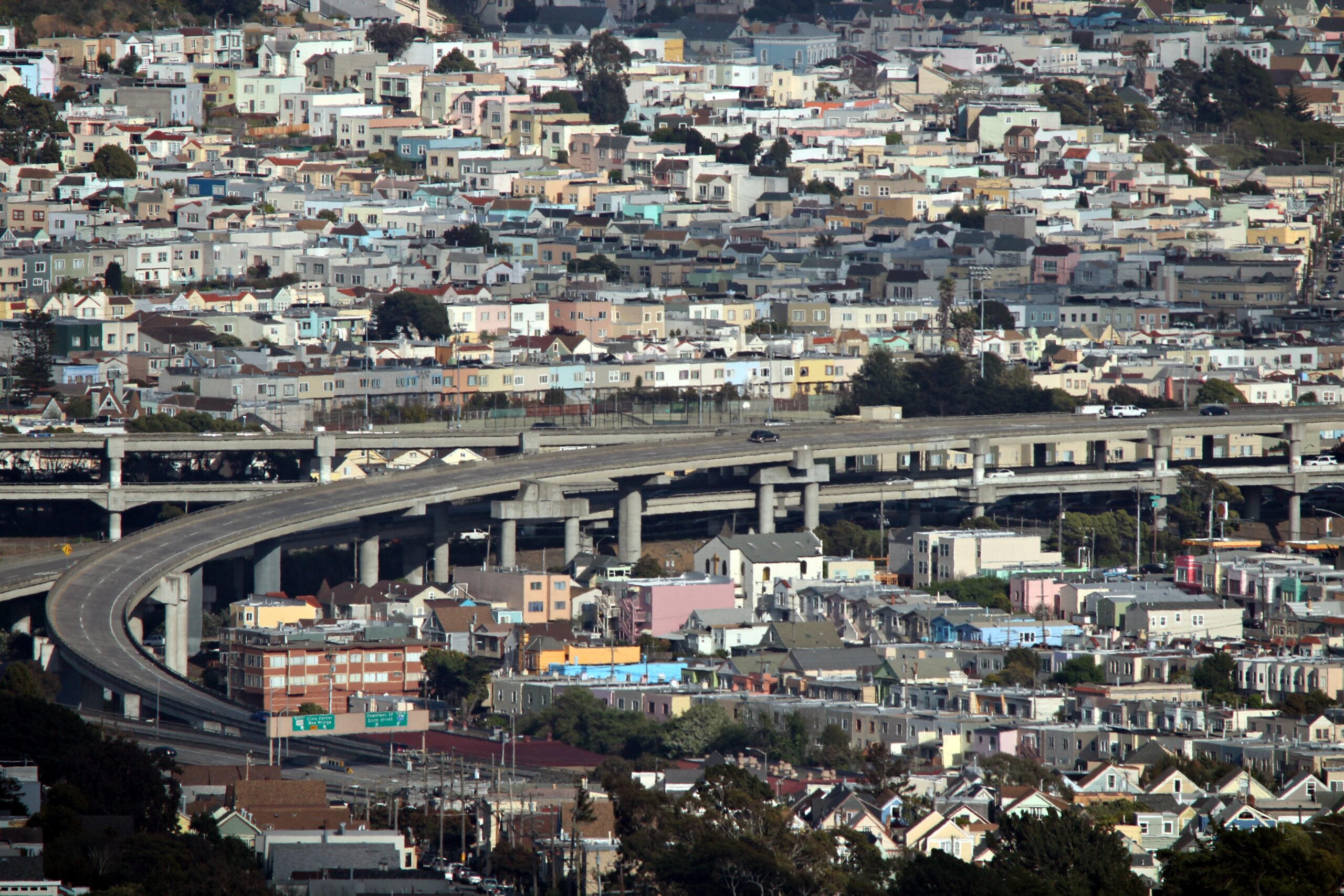It’s the Asphalt, Stupid: How Freeways Wrecked Local Economies

US Secretary of Transportation Pete Buttigieg recently announced a major federal grant for tearing down the one-mile I-375 freeway in Detroit, a monument to racial injustice that cut a deep scar through Black neighborhoods – and displaced 100,000 residents in its construction. Buttigieg also launched a $1 billion Reconnecting Communities grant program for similar efforts earlier this year.
The program has major racial justice implications for communities all across California, including Oakland’s I-980 and surrounding environs. As illustrated in a new working paper by Federal Reserve economists, federal investment in urban freeways divided communities and devastated local economies to enable subsidized access to the city for suburban commuters.
Key takeaways:
- By calibrating a model to Chicago as a case study, the authors found that freeways directly reduce quality of life for neighboring local residents and with net welfare costs “equivalent to about 5 percent of income.”
- The authors found that “one-third of the effect of freeways on central city population decline can be attributed to freeway disamenities” — negative externalities such as noise, pollution, and the physical “barrier effects” of freeways increasing local travel time.
- “Freeway revolts” that followed the initial wave of urban freeway projects in the 1950s were more likely to succeed in blocking or diverting freeways in wealthier, whiter neighborhoods with more political power.
Suburbanization and white flight in the US continued the post-Reconstruction legacy of Jim Crow-era racism by reshaping America’s built environment to hinder Civil Rights-era integration efforts. Disinvestment and spatial segregation in urban communities created a “white noose” of exclusionary white suburbs hoarding tax revenue, infrastructure and public goods from declining central cities.
Adding to the significant body of literature documenting this story, a new working paper by Brinkman and Linn (2022) from the Federal Reserve Bank of Philadelphia illustrates the real economic destruction that freeways brought to central cities in order to export prosperity to the suburbs, using stolen land and wealth from urban Black and brown neighborhoods that were literally expropriated and razed to make room for high-speed (and mostly white) commuters.
Brinkman and Linn developed a spatial equilibrium model that “considers the joint location decisions of employment and population in a city with costly commuting.” Freeways make the costs of longer commutes more attractive for residents in the suburban periphery, while making it less attractive to live next to a freeway overpass closer to the central business district. The model enables “testable predictions” about the tradeoffs between the “disamenity effect” and “commuting cost effect.”
By using this model to analyze historical data on freeway construction, travel patterns, and Census data from the Chicago metro region, Brinkman and Lin show that the costs for central neighborhoods far outweigh the benefits. In sum, “freeways have negative local effects in central neighborhoods but less negative or even positive local effects in outlying neighborhoods.”
It’s important to note that the diminishing returns of freeways in cities are a function of their centrality: “In central cities, conditioned on proximity to the city center, neighborhoods near freeways will decline more than those farther from freeways. This is because, near city centers, the commuting benefits of freeways are small relative to the negative quality of life effects of freeways.”
Perhaps most perversely, this shows that central city residents effectively subsidize lower commuting costs – and faster drive times – for suburban residents in part by bearing the disamenity “barrier” effect of longer travel times when freeways physically divide the neighborhood, making formerly short trips across the street impossible.
The authors strongly reject any prevailing counter-hypotheses that would reverse the arrow of causation in their model – for example, “freeways may have been routed through neighborhoods expected to decline.” Brinkman and Lin discount this alternate interpretation by emphasizing the model’s reliability in clearly distinguishing causes from the effects of economic decline in the real world.
“Freeways were in fact allocated to neighborhoods with superior growth potential,” they write. Brinkmann and Linn also candidly note the political implications of their findings: “Our results help explain … absolute declines in central city populations, and thus depart from the consensus among economists that freeways affect spatial structure solely by reducing transport costs.”
The social science literature is increasingly clear that actively redressing the spatial segregation that resulted from freeway expansions and related land use policies of the mid-20th century are key for achieving social and environmental justice more broadly. Inverting the classic Kennedy quip, the economic tide rises when we lift all ships.
Photo by Basil D Soufi, CC BY-SA 4.0 <https://creativecommons.org/licenses/by-sa/4.0>, via Wikimedia Commons